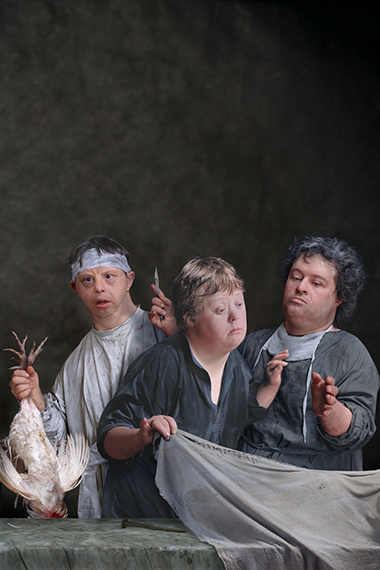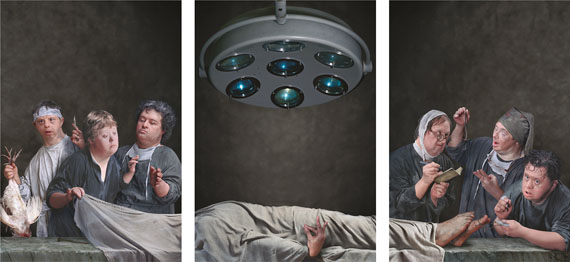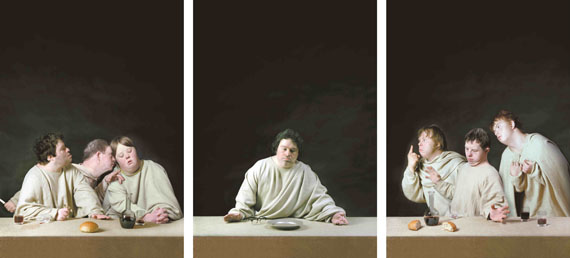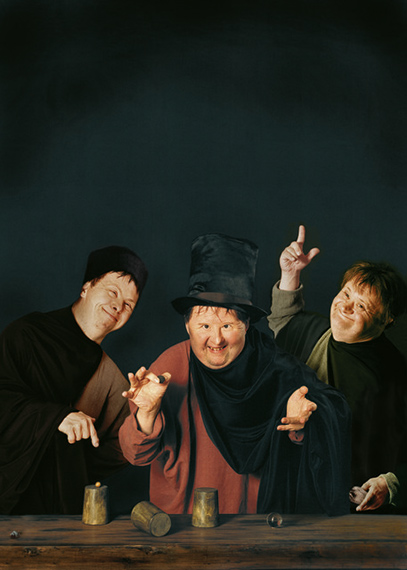
Raoef Mamedov »
Pieta
Exhibition: 8 Feb – 8 Mar 2020

Galerie Lilja Zakirova
Engstraat 6
5256 BD Heusden
+31 (0)416-661830
lilja@zakirova.com
www.zakirova.com
Thu-Sun 13-17

Raoef Mamedov
"Pieta"
Exhibition: 8 February – 8 March 2020
The photographical series titled "Pietà" (2005) by Raoef Mamedov forms the closing of his trilogy which started with "The Last Supper" and "The Games on the Window Sills".
It is no secret that the main theme of the Pietà – the grieving after Christ has been taken from the cross – has often been depicted by many different artists, with which each artlover is familiar. The cycle here displayed by Raoef Mamedov is flooded with quotes. Besides references to the Pietà there is also a clear homage to the famous painting by Rembrandt, The Anatomy Lesson of Dr. Nicolaes Tulp.
It is perhaps superfluous to mention that, just as before, the artist used people with Down’s syndrome to pose for him. Within the supposed contamination of the interior of an operating room and a anatomical cabinet the actors illustrate, dressed in medical uniforms, a new lecture of an old story. The visual quotes in the work are like the splinters of one large transcript.
The wealth of metaphors and echoes of meaning guide the more experienced viewer to Mamedov’s beloved theme of the so-called 'schizoanalysis', as described by the French philosophers Gilles Deleuze and Felix Guattari. According to this doctrine the diseased society is meeting resistance by a group of outcasted individuals (who are placed in one group together with criminals and artists by Deleuze and Guattari). With their whole being they express their skeptical views on the exclusiveness of the ruling standards, language and logic.
Within the frameworks of this 'schizofrenic discours' the characters bring us closer to the intriguing theme of the definition and the comprehension of the self through the other. The carnivalesque aspect of the depiction, his deviation of the original and the parodying tone reveal the weak spots and shortages in a worldview that once made sense. At the same time the allegoric level of the presentation draws our attention inward to our own thoughts and identity.
Mamedov renounces every tendency towards standardization. Using his actors he allows the viewer access to 'fragmented truths'. By the childlike innocence with which the characters play the staged mystery, we are forced to think about the potential quantity of possible interpretations. Their natural naivety attests an entire layer of reflective skills that are unknown to us. Together the people with Down’s syndrome form a choir that brings dissonants in the original monopoly of the standard reading of cultural codes.

"As we know Pieta literally means compassion. Within the iconography we usually mean the lamentation of Christ. With this work I tried to sneak up on the most important theme - the crucifixion. To me this seemed the right direction. Every panel of this pentaptych has its own specific meaning. In short:
The first part. Here is the depiction of the half-blind, old guard Longinus, who with his long spear penetrated Christ’s side. His spear is (in crucifiction scenes) guided in the right direction by a young soldier. Het receives the cup (the grail) with the liquid that is gathered from Christ’s wound by Joseph of Arimathea. Next to him stands the lamenting mother. She has no time for the miracles that are performed by the miraculous liquid from the grail. She professes pity for her dead son in an extremely human manner.
The second part. Here we see Peter with the rooster, who has forever lost his mind. And the ghost of Judas who, in the figure of the pathologist, is about the perform an autopsy on the body of Christ. And finally the mourning, youthful James.
The third part. Here all is clear. The lamp above the operating table as the all-seeing eye of God, and at the same time the postmodern irony of it.
The fourth part. As we remember from Iconography the negative figures are displayed on the left of Christ. In this case this is where the registration of the nails, that are taken from Christ’s body, takes place. To this day theologists are having arguments about the amount of nails with which Christ was crucified – was it three or four? Meanwhile a nurse writes the name of the deceased on a toe-tag.
The fifth part. These are the three criminals, fighting amongst themselves about the cloth of Christ.
(Raoef Mamedov)

